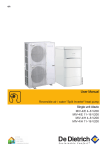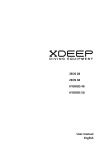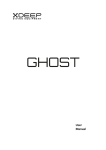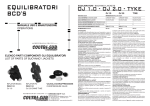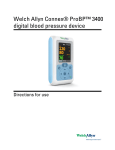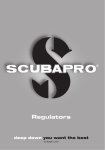Download USE AND MAINTENANCE MANUAL Stabilizing Jackets
Transcript
USE AND MAINTENANCE MANUAL Stabilizing Jackets SCUBA ONE declines any responsibility for possible mistakes in this operation and maintenance manual. Due to the constant improvements of its products, SCUBA ONE reserves the right to modify them, saving the essential characteristics here to described and illustrated. Planning, design, production and technical assistance are carried out entirely in ITALY. All materials used are certified non-toxic and non-allergenic in contact with the skin, all in compliance with the protection of the health of the user, workers and the environment. Each stabilizing jacket is individually tested to test the pressure seal, the operation of the valve and the hose connection. INTRODUCTION The SCUBA ONE stabilizing jackets are the result of a new project geared to maximum reliability and ease of use. It has been designed, developed and built by SCUBA ONE, a long-established leader in the field. All our stabilizing jackets are certified according to European standards EN1809, EN250. DANGER WARNINGS: This manual includes graphic symbols for highlighting the risks and dangers which can be faced during the use and maintenance of the SCUBA ONE stabilizing jackets. These graphic symbols and their associated captions are: DANGER : Indicates an imminent hazard which, if not avoided, may result in serious injury or death. WARNING : Indicates a potential hazard which, if not avoided, may result in serious injury or death. CAUTION : Indicates a potential hazard which, if not avoided, may result in slight or moderate injury. May also indicate the unsafe execution of a procedure. WARNING : This user manual is NOT a substitute for the specialist diver certification for use of the SCUBA ONE stabilizing jackets! Read the entire manual before using this equipment! The user manual must be retained for the entire period of the product life! DANGER : Do not use this stabilizing jacket until you have acquired the specific license. Use of this stabilizing jacket by divers who have not obtained the required license, may result in serious injuries or death. This stabilizing jacket should be used up to the depth of 50 meters. This stabilizing jacket is not a life jacket and does not guarantee to support the head out of the water in surface. WARNING : A bad or improper use of this stabilizing jacket could result in a loss of trim, including rapid and uncontrolled ascents and descents, with the risk of drowning or decompression sickness. DANGER : Diving in an environment that is chemically, biologically, or radiologically contaminated is extremely dangerous. The stabilizing jackets SCUBA ONE must not be used in contaminated environments. DANGER : Diving in ice water (in water at 5°C or less) is extremely dangerous. Do not dive in ice water unless you have been fully trained and with specially dedicated equipment. DANGER : It is essential to take good note of these hazard and danger symbols to avoid critical situations that may occur while using the SCUBA ONE stabilizing jackets. Such situations may result in serious injury or death. General warnings Before using the stabilizing jacket or any other product for diving you must follow a course held by qualified instructors and obtain the relative license. The use of diving equipment by unqualified persons is dangerous and may result in serious injuries or death to the diver and his companions. During the assembly and setting of the stabilizing jacket, have been implemented all possible precautions to provide a highly reliable product during a long time. These steps can be made ineffective if the user does not use the stabilizing jacket properly and fails the appropriate maintenance. SCUBA ONE declines all responsibility for any problems resulting from failure to follow the recommendations described in this manual. For all other issues, please contact your dealer or directly SCUBA ONE. To ensure maximum safety every repair or maintenance must be performed only by laboratories authorized by SCUBA ONE. If you are not expert in the use of this equipment you should become familiar with its operation during test dives in shallow water and favorable conditions; possibly contact a qualified instructor for a refresher course. These stabilizing jackets have been certified in accordance with EN 250 and EN 1809 that involve a long series of functional tests to a maximum depth of 50 meters and at temperatures between –20° C and +70° C. These stabilizing jackets have been designed to be used with normal atmospheric air conform to requirements for breathable air as established in CEN EN 12021. The use of this or any other SCUBA ONE product with oxygenenriched gas or mixtures (commonly known as NITROX) requires specific preparation and compliance with laws of the country where the equipment is used. If this is not done according to recommendations, it may cause serious or fatal injury due to fires or explosions, or seriously cause damage to the equipment. References to European Norm EN 250 The objective of the requirements and tests established by Norm EN 250 is to guarantee the minimum functional safety of SCUBA (SELF CONTAINED UNDERWATER BREATHING APPARATUS) gear at a maximum depth of 50 meters. Definition of Scuba (EN 132): A cylinder containing an open circuit, compressed air breathing apparatus for underwater use. SCUBA - Minimal apparatus required (EN 250): 1. Cylinder and valve set (assembled cylinder) 2. Regulator 3. Pressure gauge or pressure control device, reserve, or alarm 4. A support, transport and connection system for the diver (back plate and harness) 5. Mask (diving mouthpiece or full mask or helmet) 6. Instructions for use Limitations (EN 250): Maximum depth 50 meters The SCUBA ONE stabilizing jackets described in this manual can be used in the SCUBA group and certified to conform to European Directive 89/686/CE and Norm EN 250: 2007. References to European Norm EN 1809 Scope: The EN 1809 standard allows the verification of minimal safely and performance standards for inflatable stabilizing jackets definition (EN 1809): A device that allows the diver to control his buoyancy while diving. Limitations: It is not the scope of the EN 1809 standard to establish requirements for floatation devices or life vests. The stabilizing jacket is not intended to guarantee an upright position of the head in cases of unconsciousness or other incapacities while on the surface or underwater. The following instructions must be integrated with those of the other components of your SCUBA (tank assembly). Before using your tank assembly, carefully read all of the instructions for usage as found in the relative manuals. In order to guarantee the maximum attention to safety, on the stabilizing jacket is sewn a label bearing the following text: This stabilizing jacket is not a life vest and does not guarantee support on the surface with your face out of the water! Before using this stabilizing jacket, you must follow a course held by qualified instructors and obtain the relative qualification. The use of diving apparatus by unqualified persons is dangerous and may cause serious or fatal incidents to the diver and his companions This stabilizing jacket can be assembled on a single cylinder up to 18 liters (Ø 220 mm) or on twin cylinders of 10 + 10 liters. Read the attached Instruction Manual carefully. Before each use, ensure that this stabilizing racket is functioning properly. Carefully screw the stabilizing jacket hose to a lowpressure outlet of the first stage of the regulator, ensuring that the thread is of the same type! An eventual intake of high pressure in the hose may cause damage, death or serious injury! Following each dive, including those in swimming pools or fresh water, this stabilizing jacket must be rinsed with fresh water inside and out. Keep this stabilizing jacket partially inflated in a cool, ventilated location. Lack of maintenance may cause damage to this stabilizing jacket or cause it to not function correctly. There is a table of the various buoyancy forces in kilograms and Newton on back of this label. Technical characteristics INNER AND OUTER BAG They consist of an inner tube in Textane 210 and an outer bag in Cordura ® 1000 or 500, polyester 600 or Kevlar. HARNESS AND SHOULDER STRAP SYSTEM Reinforced polypropylene straps and hooks AISI 316 stainless steel and acetal resin. The sliding buckles allow adjustment in four points (two shoulder straps, sternum strap and abdomen belt) so as to adapt the size S to XXL. Buoyancy force of the stabilizing jackets: Model DSI / 20: 180 Newtons, 18,35 kilograms Model DSI / 28: 230 Newtons, 23,45 kilograms Model DSI / 40: 340 Newtons, 34,67 kilograms POWER INFLATOR AND OVERPRESSURE VALVES For safety reasons, we recommend that the first time you try to use the inflate button when you are in surface. The power inflator of the stabilizing racket controls a large number of functions: The side button allows the graduate intake of air inside the stabilizing jacket; a rapid and firm pressure on the button corresponds to a quick intake The top button (at the end of power inflator) allows the inflation by mouth with a special mouthpiece: push the button and in the same time blow inside the mouthpiece. The top button (at the end of power inflator) allows the deflation by raising the corrugated upwards and pressing the top button. Overpressure valves The stabilizing jackets are supplied with two or three overpressure valves located behind on the right side at the bottom and at the top. The overpressure valves guarantee the quick dumping of air. The function of these valves is to automatically reduce the internal pressure of the bag in case of excessive inflation or in case of eventual necessity during the various phases of diving. The valves can be opened manually pulling of the cable located on the valve itself. Diving with a stabilizing jacket BEFORE DIVING CONNECT THE STABILIZING JACKET TO THE CYLINDER The first step to be taken is to attach the stabilizing jacket to the cylinder, positioning the cylinder with the outlet valves facing you, insert the stabilizing jacket, maintaining the rear part of the back pack in front of the valve. Tighten the band on the cylinder and close the special buckles; secure any excess strap length using the special strips provided. By tightening the band on the cylinder while dry you may notice loosening of tension when diving with consequential slipping of the cylinder. We therefore recommend wetting the bands before carrying out this operation! At this point, put on the stabilizing jacket and assume an erect position, lowering the nape of your neck backwards: if your body position is correct, you should have no problem carrying out this operation. At the same time, check that the base of the cylinder does not move downwards excessively, disturbing your movements We advise you to mark a fixed reference point on the cylinder- for example, a strip of adhesive tape or painted line - so that you can always re-assemble your stabilizing jacket in the correct position. This procedure may seem excessive, but it will guarantee comfort and correct use of the stabilizing jacket for all future dives. Remember that the attachment system is designed to assemble a single cylinder (with a minimum diameter of 140mm and a maximum of 220mm) to the stabilizing jacket with no additional accessories required. You can attach also twin cylinders with the appropriate accessories. CONNECT THE LOW PRESSURE HOSE TO YOUR REGULATOR The stabilizing jacket is provided with a low pressure hose (LP) that provides low pressure air to the inflator. The hose must be screwed in one of the outputs of low-pressure (LP) of your first stage regulator. WARNING : Use only air to inflate the jacket. The use of enriched oxygen can cause fire and explosion. SCUBA ONE always uses certified hoses according to European standards EN 1809, EN 250 and EN 14225-2, with working pressure 35 bars; the thread is standard 3/8” UNF and the quick release can be operated even when wearing thick gloves. The flow of the gas supplied to the inflator is abundant, there are no pressure drops even in extreme cold. WARNING : Never connect the low pressure hose to a high-pressure port (HP) on your first stage regulator. If the hose is connected to a high-pressure port, may stop working without warning, causing serious injury to the diver. The regulators first stages have the low pressure ports (LP) smaller then the high pressure ports (HP). In any case, you must pay attention to the old regulators where the ports HP and LP were all the same. In most cases, the ports HP are marked HP. In any case, no doubt, carefully checked the outlet pressure. The maximum pressure at a LP port should be 14 bar. Once it is localized the LP port and has removed the plug, make sure that the hose O-Ring is present and in good condition. Also check if the threads of the hose and ORings are free of dirt and debris. Install the threaded portion of the hose in the port using a 14mm wrench. Do not overtighten (exactly a torque of 14.7 Nt.). WARNING : If the hose supplied with your SCUBA ONE stabilizing jacket is bent, twisted or forced when worn, the inflator may not work properly; replace it immediately with a new hose SCUBA ONE. After opening the cylinder valve, connect the quick release attach with the male connector on the inflator taking between thumb and forefinger the collar of the quick release attach, slide it back and press down firmly on the male connector of the inflator, then release the collar. To disconnect the quick release attach simply slide back the collar and the hose will release automatically. Arrange the shoulder straps and the belts to the maximum expansion for easy donning, slide the shoulder straps until you get the maximum opening and proceed to wear the weight belt. Slide your arms through the shoulder straps taking care to leave over your shoulder all the low and high pressure hoses. Inhale deeply and tightened the straps on the shoulders, chest and abdomen, making it adheres well to the body so it does not hinder or impede movement or cause any sensation of suffocation. The sliding buckles allow adjustment in four points (two shoulder straps, sternum strap and abdomen belt) to adapt from size S to XXL. Be careful, always partially deflate the stabilizing jacket before entering the water to compensate for any additional weight. Start the dive deflating the bag using: Option 1 – put the inflator over your shoulders and press the exhaust button on the top (slow discharge) Option 2 - pull the knob on the cord of the pressure relief valve (rapid discharge). Once you start the descent, the speed tends to increase: short bursts of load button allows you to adjust it. To the desired depth, by the load button, always established neutral buoyancy with small inputs and calibrated air. During the ascent, maintain a slightly negative attitude to earn the surface. WARNING : Improper use of the inflator can cause you to lose rapidly buoyancy and uncontrolled ascents and descents, with serious consequences. In surface inflate the stabilizing jacket to have a positive attitude; to undress the jacket open or loosen the buckles on shoulder, chest and abdomen. WARNING : The stabilizing jacket is used to compensate underwater trim, cannot be used to lift heavy objects from the bottom since this could cause uncontrolled ascents with serious consequences. CARE AND MAINTENANCE OF YOUR STABILIZING JACKET SCUBA ONE All SCUBA ONE stabilizing jackets are manufactured in Italy and individually tested with strict criteria of quality control. The proper maintenance of your stabilizing jacket will be extremely useful to extend its life. When you finish diving for the day, rinse thoroughly with fresh water both the external and the internal face. To do this, enter the fresh water through the drain button air of the inflator, then flip the jacket and empty it by pressing the same exhaust button. Rinse carefully the drain and load valves. Dry the valves with compressed air after rinsing. Let the jacket dry in the shade. Do not put the jacket with objects that could puncture or damage the bag, avoid contact with solvents, oils, gasoline. Put the jacket perfectly dry, partially inflated, in a cool and airy place. WARNING : The valves of the stabilizing jacket must be cleaned after each use exactly as your regulator. The load valve may be sticky due to the accumulation of salt. The exhaust valves may be clogged due to deposits of salt or limestone inside the mechanism. CAUTION : Do not hang your stabilizing jacket in full sun. STORAGE OF THE STABILIZING JACKET Proper storage will extend the life of your stabilizing jacket. Keep it in a cool, dry place and away from direct sunlight. The place of storage should be free of ozone generators, such as electrical machinery or gas. If the manual is not available or you have lost it, you can download a copy from the website SCUBA ONE at the address www.scubaone.it or you can request a copy by contacting the SCUBA ONE at the following address: Via Andrea Costa 9 73011 Alezio (LE) tel. e fax +39.0833.299128 e-mail [email protected]










